Configure the First EFT Connection
You must first configure the local connection before you can configure a remote location.
To configure EFT on the local computer
-
After installation is complete, the New Administrator Connection wizard appears. (If you have already defined a connection and want to create another one, refer to Creating a Remote Connection.)
-
Leave This computer selected, then specify the Label for the local connection. By default, the label is LocalHost. Because LocalHost is a very common label, it is a good idea to change the label to something that is easily identifiable in error logs, reports, and remote connections. For example, GS_EFTS. You can label EFT anything you want; the EFT name is not dependent upon the computer name. The EFT Administrator Login page appears.
- Click the Authentication box and specify the type of authentication to use for this login. Future connections will default to the authentication type that you specify during this initial login, but you can choose a different type. Authentication types include:
- EFT Authentication - Choose this option to log in with an EFT-specified administrator account, such as the one you created during installation.
- Integrated Windows Authentication - Choose this option to log in as the currently logged on user (Integrated Windows Authentication).
- Windows Authentication - Choose this option to log in using a specific Windows account.
- If you specified EFT Server Authentication or Windows Authentication, in the Username and Password boxes, provide the login credentials that you created during installation. The Welcome page appears. Because you have not yet activated the software, the "Free Trial" reminders appear. After you activate, you will not see this prompt.
- Do one of the following:
- If you are evaluating the software or just do not want to activate yet, click Start Trial, then follow the procedures in Creating and Configuring an EFT Server.
- If you have purchased a license, click Activate Now, then follow the procedures for activating the software.
- Click Next. The Server Setup wizard Welcome page appears.
- If you are not restoring from a backup, click Next.
- If you are restoring from a backup, click Restore from Backup, then refer to Backing Up or Restoring Server Configuration for the procedure.
- Click Next. The FIPS Options page appears.
- To use FIPS for SFTP (SSH2), select the Enable FIPS for SFTP check box. To use FIPS for SSL, select the Enable FIPS for SSL check box.
- A confirmation prompt appears when you select either check box. When you enable FIPS, the EFT service must be restarted. Click OK to continue with FIPS enabled or click Cancel if you do not want to use FIPS and restart the EFT service.
- Click Next. The Remote Administration page appears.
- If you do not want to allow remote administration, clear the Allow remote administration check box.
- If you want to allow remote administration:
- Select the Allow remote administration check box and specify the Listening IPs.
- Click Configure to specify one or more IP addresses. The Listening IP Settings dialog box appears.
- All Incoming (IPv4) is selected by default. Select the check boxes for addresses that you want to allow; clear the check boxes for the addresses that you do not want to allow, then click OK.
- Specify the Listening port. (For security best practices and compliance with the PCI DSS, specify a port other than the default of 1100.)
- Click Next. If you chose remote administration, the Secure Remote administration page appears.
- Administrator account credentials are transmitted in plaintext unless SSL is enabled. Organizations complying with the PCI DSS are required to use SSL for remote administration. To enable secure remote administration, select the Use SSL for secure remote administration check box, and then click Next. The SSL Certificate Options page appears.
- Do one of the following:
- In the Certificate
and Private Key boxes,
click the folder icon
 to browse for the private key pair files.
to browse for the private key pair files.
- Click Create certificate to create one. Refer to SSL Certificate-Based Login, Creating Certificates and Importing a Certificate into the Trusted Certificate Database for information regarding certificates.
- Click Next. The Auditing and Reporting page appears.
- If you are using Auditing and Reporting, select the Enable auditing check box, then provide the information required to connect to the ARM database as described below. If you are not using Auditing and Reporting, skip to the next step. (Auditing and reporting is a requirement of the PCI DSS.)
- In the Database type area, specify whether you are using SQL Server or Oracle for the auditing database.
- In the Host[\Instance Name] box, type EFT name or IP address.
- In the Authentication box, specify the type of authentication used by the database, either Windows Authentication or SQL Server Authentication.
- If you choose SQL Server Authentication, you must also specify the "sa" username and password. In the Username and Password boxes, type the username and password used to connect to the database (not the EFT credentials).
- In the Database Name box, type the name of the database.
- In the In case of audit database error area, specify an Action for EFT to take if there is an error with the database. To stop recording data, select Stop auditing. To continue recording data to a file, select Audit to folder, and specify the location for the log file.
- To try to recover from a database error automatically, select the Attempt to reconnect every check box and specify the frequency in seconds.
- In the email notification area, select the Notify on disconnect check box and/or the Notify on reconnect check box, and then specify the email address(es) to which EFT is to send database connection error notifications. You can add as many email addresses as needed; separate the addresses with a comma or semicolon. EFT uses its global SMTP email settings from the SMTP Configuration to send the emails. You will configure those settings on the next page.
- The Refresh statistical fact tables daily check box is selected by default. If you do not want the database fact tables to be refreshed as part of EFT's hard-coded nightly cleanup routine (at midnight), then clear the check box.
- Click Next. The specify SMTP Server Settings page appears.
- To specify your email server settings for outbound email notifications, click the drop-down box and select SMTP (default), GMail Oauth, or Office 365 Oauth. The options on this page of the wizard change based on your selection.
- In the SMTP host address boxes, specify the SMTP server host address and port.
- Select the Use Implicit TLS check box, if needed.
- If using the SMTP server, select the Enable authentication check box and provide the Username and Password.
- In Service account credentials, click Browse and select the file that contains the Service account key json path file. The fields will be completed with the information from the JSON file.
- Complete the fields to connect to the Office 365 mail server:
- Office 365 Account -
- Client ID -
- Client Secret -
- Tenent ID -
- In the From email address box, specify the email address for email notifications (such as those triggered by Event Rules). This is the address that appears in the From box of emails sent by EFT. For example, type noreply@serverhost.com.
- Click Send Test Email to ensure the credentials are correct.
- Click Next. The Automate Service Account Settings page appears.
- Click Next. Server Setup is complete.
- Click an option, then click Finish. If you chose FIPS mode for SSL and/or SSH, prompts appear explaining that EFT has entered FIPS mode. Click OK to dismiss the prompts.
- If you chose Run the Site Setup wizard now, the Site Setup wizard Welcome page appears.
- Next, refer to Creating a Site for the procedure for configuring the first Site.

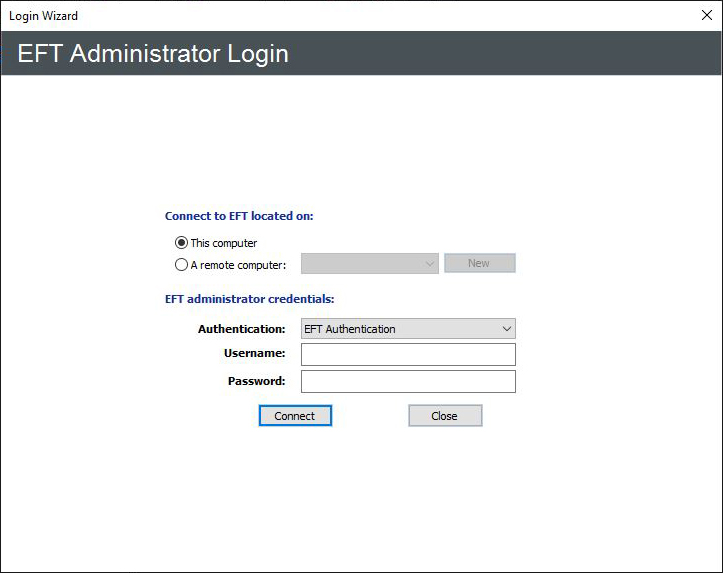

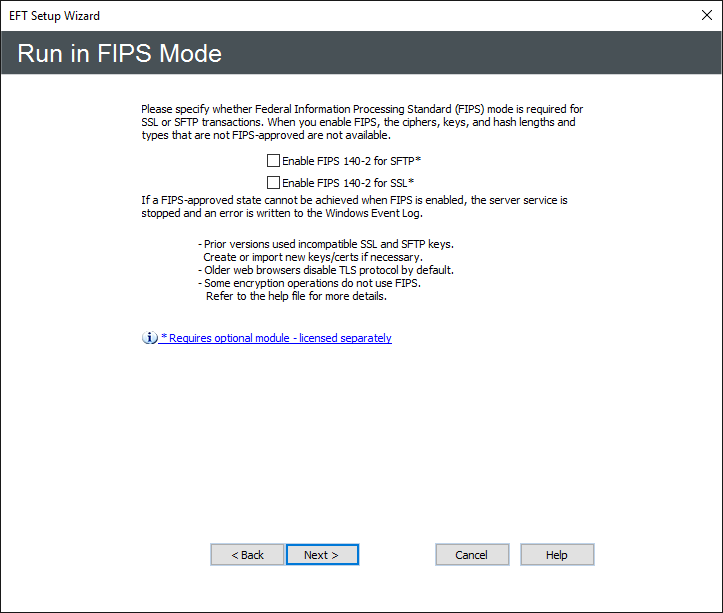
When you enable FIPS mode, the ciphers, keys, and hash lengths and types that are not FIPS approved are not available. If a FIPS-approved state cannot be achieved when FIPS is enabled, the EFT service is stopped and an error is written to the Windows Event Log.
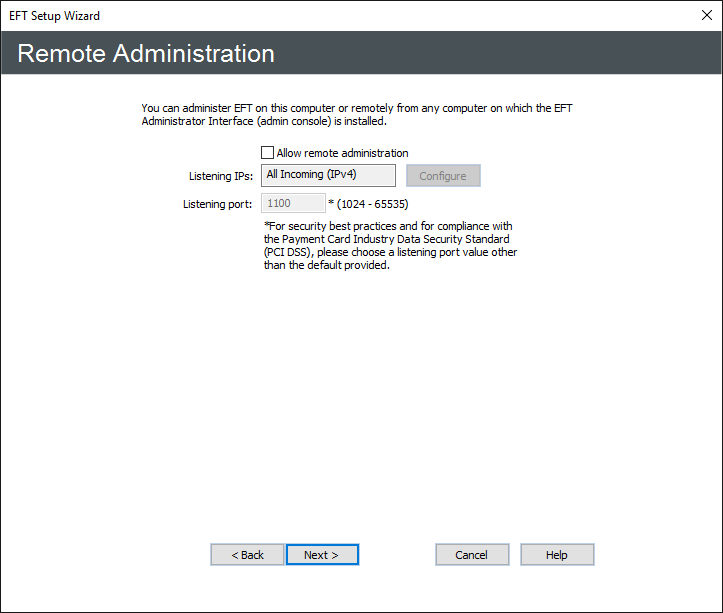
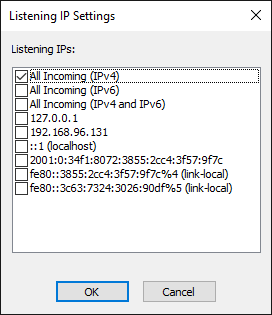
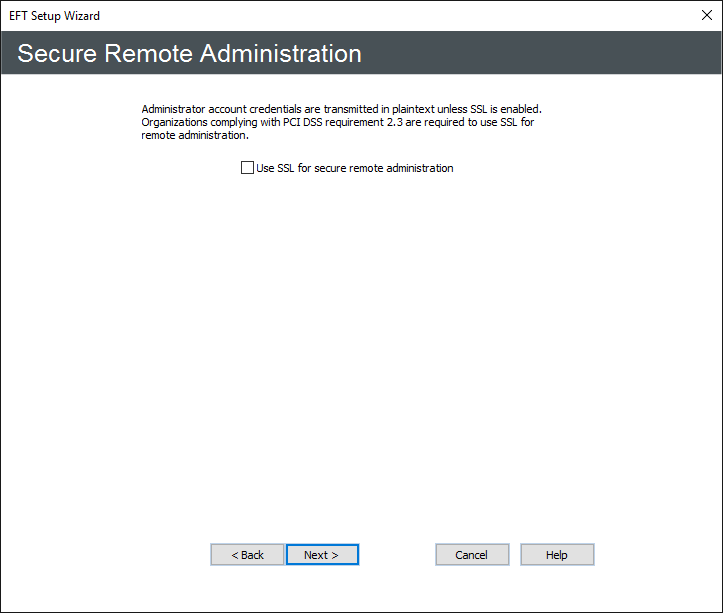

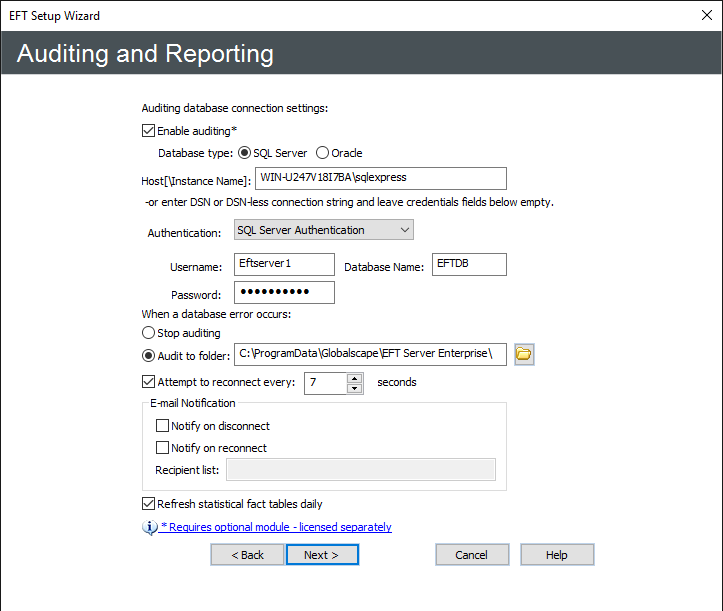
If you are using SQL Server as the Auditing Database, \InstanceName corresponds to SQL Server's notion of named instances, a feature that allows a given computer to run multiple instances of the SQL Server Database Service. For more information, refer to http://msdn2.microsoft.com/en-us/library/ms165614.aspx
UNC paths are supported. The Globalscape Server service must run on a computer that has access to the network share, and the full UNC path must be used, that is: \\xcvd.forest.intranet.xc\Common_Files, not G:\Common. IPv6 literals must use the Microsoft-specific IPv6 address form that uses "ipv6-literal.net" for use in a UNC path. (Refer to the Wiki article about IPv6 for more information about IPv6 literals in UNC paths.)
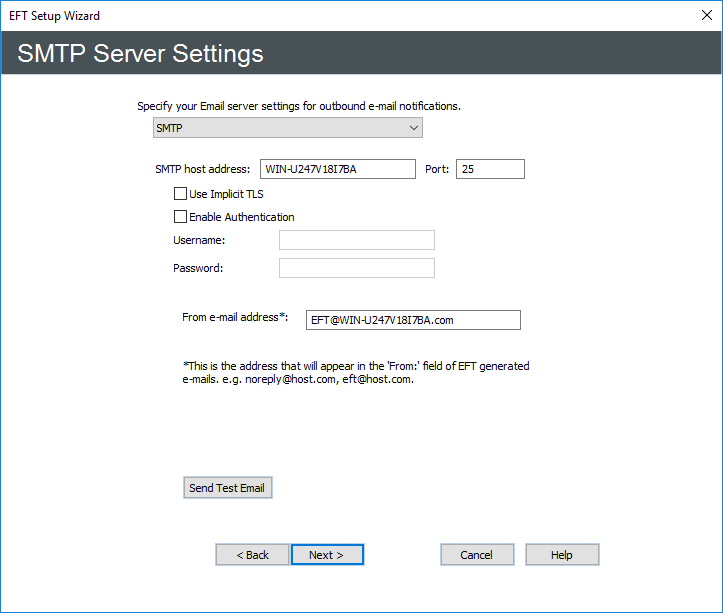
For SMTP
For Gmail Oauth
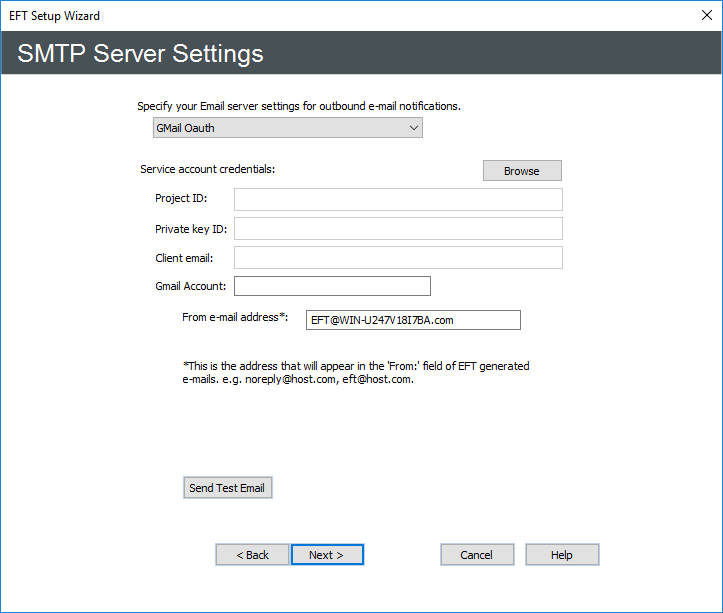
For Office 365 Oauth
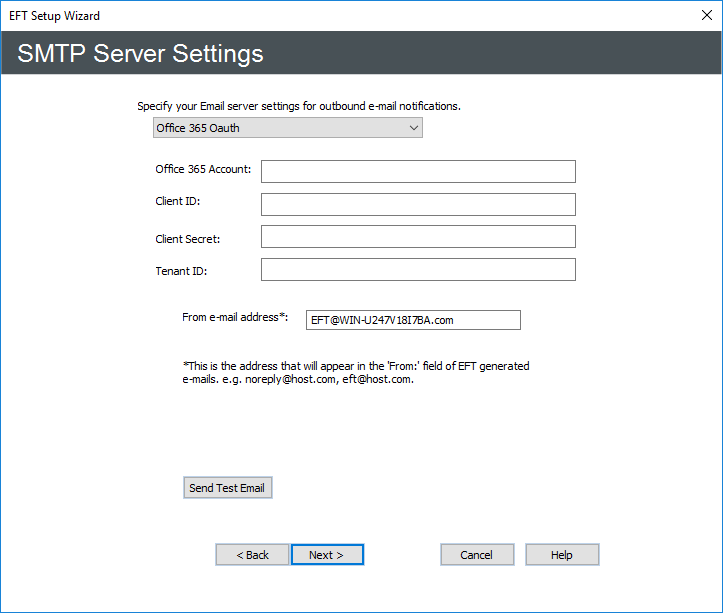
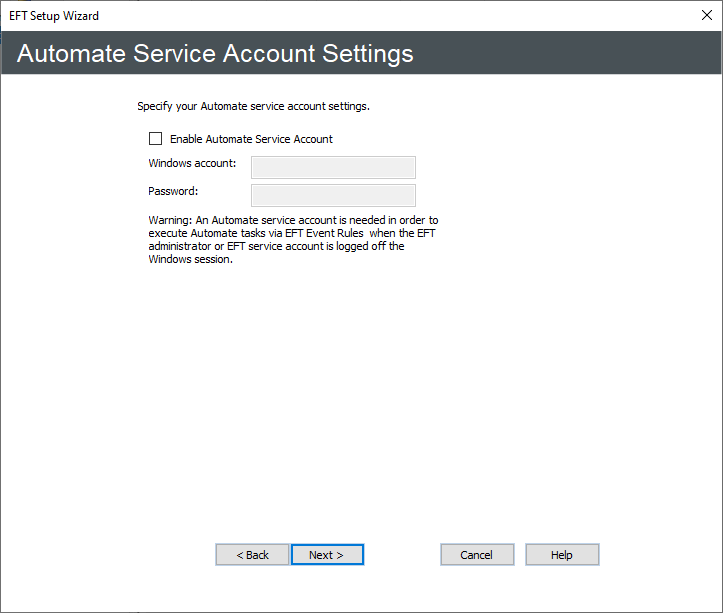
The Automate Service Account must be enabled and provided Windows account credentials so that the Automated Workflows can continue to run in event rules when the Windows session is logged out or locked or EFT server service account is logged out. Select the Enable Automatic Service Account check box and provide the Windows credentials.
You are offered the option of continuing to the Site Setup wizard, or quitting the wizard, saving EFT settings, and configuring the Site(s) later. You must configure at least one Site (a virtual host) to service inbound connections to EFT.